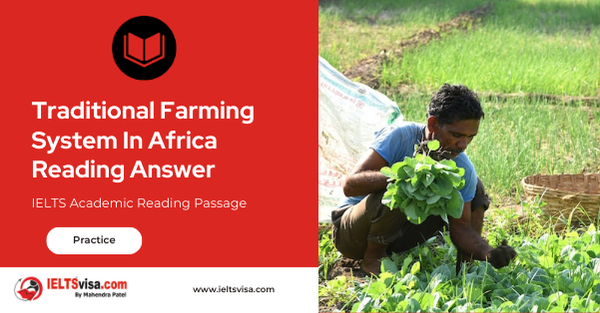Traditional Farming System In Africa Reading Answer
IELTS Academic Reading Passage
The margins of dambos are sometimes planted to local varieties of rice during the rainyseason, and areas adjacent to vegetables irrigated with water from the dambo during thedry season. The extent of cultivation is very limited, no doubt because the growing of crops under dambo conditions calls for a great deal of skill. Near towns some of the vegetable produce is sold in local markets.
G.
Fishing has long provided a much needed protein supplement to the diet of Luapulans, as well as being the one substantial source of cash. Much fish is dried for sale to areas away from the main waterways. The Mweru and Bangweulu Lake Basins are the main areas of year-round fishing, but the Luapula River is also exploited during the latter part of the dry season. Several previously abundant and desirable species, such as the Luapula salmon or mpumbu (Labeo altivelis) and pale (Sarotherodon machochir) have all but disappeared from Lake Mweru, apparently due to mismanagement.
H.
Fishing has always been a far more remunerative activity in Luapula that crop husbandry. A fisherman may earn more in a week than a bean or maize grower in a whole season. I sometimes heard claims that the relatively high earnings to be obtained from fishing induced an ‘easy come, easy go’ outlook among Luapulan men. On the other hand, someone who secures good but erratic earnings may feel that their investment in an economically productive activity is not worthwhile because Luapulans fail to cooperate well in such activities. Besides, a fisherman with spare cash will find little in the way of working equipment to spend his money on. Better spend one’s money in the bars and have a good time!
I.
Only small numbers of cattle or oxen are kept in the province owing to the prevalence of the tse-tse fly. For the few herds, the dambos provide subsistence grazing during the dry season. The absence of animal draft power greatly limits peoples’ ability to plough and cultivate land: a married couple can rarely manage to prepare by hand-hoeing. Most people keep freely roaming chickens and goats. These act as a reserve for bartering, but may also be occasionally slaughtered for ceremonies or for entertaining important visitors. These animals are not a regular part of most peoples’ diet.
J.
Citemene has been an ingenious system for providing people with seasonal production of high quality cereals and vegetables in regions of acid, heavily leached soils. Nutritionally, the most serious deficiency was that of protein. This could at times be alleviated when fish was available, provided that cultivators lived near the Valley and could find the means of bartering for dried fish. The citemene/fishing system was well adapted to the ecology of the miombo regions and sustainable for long periods, but only as long as human population densities stayed at low levels. Although population densities are still much lower than in several countries of South-East Asia, neither the fisheries nor the forests and woodlands of Luapula are capable, with unmodified traditional practices, of supporting the people in a sustainable manner.
Overall, people must learn to intensify and diversify their productive systems while yet ensuring that these systems will remain productive in the future, when even more people will need food. Increasing overall production offood, though a vast challenge in itself, will not be enough, however. At the same time storage and distribution systems must allow everyone access to at least a moderate share of the total.
Questions 1-4
Complete the sentences below with words taken from Reading Passage!.
Choose NO MORE THAN TWO WORDS from the passage for each answer. Write your answers in boxes 1-4 on your answer sheet.
1. In Luapula land allocation is in accordance with 1……………….
2. The citemene system provides the land with 2…………………….. where crops are planted.
3. During the second season, the last planted crop is 3………………..
4. Under suitable conditions, fruit trees are planted near 4…………………
Questions 5-8
Classify the following items with the correct description. Write your answers in boxes 5-8 on your answer sheet
A. fish
B. oxen
C. goats
5…………………… be used in some unusual occasions, such as celebrations
6 ……………….. cannot thrive for being affected by the pests
7 ………………….. be the largest part of creating profit
8 ………………….. be sold beyond the local area
Questions 9-12
Do the following statements agree with the information given in Reading Passage 1? In boxes 9-12 on your answer sheet, write
TRUE if the statement is true
FALSE if the statement is false
NOT GIVEN if the information is not given in the passage
9 …………………… People rarely use animals to cultivate land
10 ………………….. When it is a busy time, children usually took part in the labor force
11 ………………… The local residents eat goats on a regular time
12 …………………… Though citemene has been a sophisticated system, it could not provide enough protein
Questions 13
Choose the correct letter. A, B, C or D.
Write the correct letter in the box 13 on your answer sheet.
What is the writer’s opinion about the traditional ways of practices?
A They can supply the nutrition that people need
B They are not capable of providing adequate support to the population
C They are productive systems that need no more
D They will be easily modified in the future

Solution For: Traditional Farming System In Africa Reading Answer
| 1. need | 8. A |
| 2. ashes | 9. TRUE |
| 3. cassava | 10. NOT GIVEN |
| 4. houses | 11. TRUE |
| 5. c | 12. TRUE |
| 6. B | 13. B |
| 7. A |
Review and Practice
- Regularly practice with IELTS reading samples and time yourself to get used to the pressure of the exam.
- Review your mistakes to understand where you went wrong and how to avoid similar errors in the future.
Our Books
Master IELTS Speaking Part 1
IELTS Writing Task 1 Book
IELTS Writing Task 2 Book
Traditional Farming System In Africa Reading Answer Explanation
Comin Soon
Practice IELTS Other Modules
IELTS Listening
The IELTS Listening test assesses how well you can understand spoken English in various contexts. It lasts about 30 minutes and is divided into four sections with a total of 40 questions. The listening tasks become increasingly difficult as the test progresses.
IELTS Academic Reading
The IELTS Academic Reading section assesses your ability to understand and interpret a variety of texts in academic settings. It is designed to evaluate a range of reading skills, including skimming for gist, reading for main ideas, reading for detail, understanding inferences, and recognizing a writer's opinions and arguments.
IELTS Speaking
The IELTS Speaking test assesses your ability to communicate in English on everyday topics. It lasts 11-14 minutes and consists of three parts: introduction, cue card, and a discussion based on the cue card topic.
IELTS General Reading
IELTS General Reading tests your ability to understand and interpret various types of texts. Here are some key areas and types of content you can expect to encounter in the reading section, along with tips for effective preparation.
IELTS Academic Writing Task 1
In IELTS Academic Writing Task 1, you are presented with a visual representation of information, such as graphs, charts, tables, or diagrams, and you are required to summarize, compare, or explain the data in your own words.
IELTS General Writing Task 1
In IELTS General Writing Task 1, you are required to write a letter based on a given situation. The letter can be formal, semi-formal, or informal, depending on the prompt. Here’s a breakdown of the key components to include in your letter
IELTS Academic Writing Task 2
In IELTS Academic Writing Task 2, you are required to write an essay in response to a question or topic. Here’s a guide to help you understand the essential elements of this task
IELTS Exam Tips
To succeed in the IELTS exam, practice regularly, familiarize yourself with the test format, improve your vocabulary, develop time management skills, and take mock tests to build confidence.
Grammer for IELTS
Grammar is the foundation of effective communication in English. Understanding tense usage, subject-verb agreement, and sentence structure enhances clarity and coherence in writing and speaking.
Vocabulary for IELTS
Vocabulary plays a crucial role in the IELTS (International English Language Testing System) exam, especially in the Speaking and Writing sections. Here’s an overview of why vocabulary is important and how it impacts your performance
RECENT IELTS SAMPLES QUESTIONS AND ANSWERS
Walking with dinosaurs
Peter L. Falkingham and his colleagues at Manchester University are developing techniques that...
Money as the Unit of Amount Reading Answers
The most difficult aspect of money to understand is its function as a unit of account. In...
WEATHERING IN THE DESERT
In the deserts, as elsewhere, rocks at the earth's surface are changed by weathering, which...
Nature on Display in American Zoos
The first zoo in the United States opened in Philadelphia in 1874, followed by the Cincinnati...
Can We Prevent the Poles From Melting
Such is our dependence on fossil fuels, and such is the volume of carbon dioxide we have...
Air conditioning the earth reading answers
The circulation of air in the atmosphere is activated by convection, the transference of heat...













